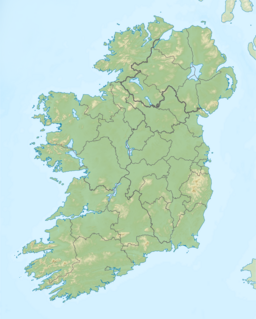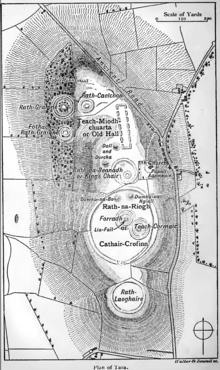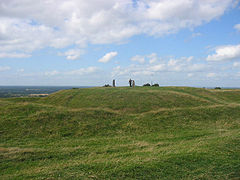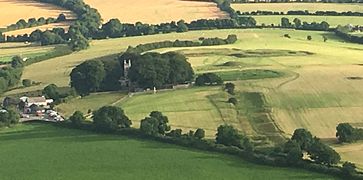Hill of Tara
| Hill of Tara Cnoc na Teamhrach | |
|---|---|
 The Lia Fáil (Stone of Destiny) atop the Hill of Tara, County Meath | |
| Highest point | |
| Elevation | 155 m (509 ft) [1] |
| Prominence | 84 m (276 ft) [1] |
| Coordinates | 53°34′39″N 6°36′43″W / 53.57750°N 6.61194°W / 53.57750; -6.61194Coordinates: 53°34′39″N 6°36′43″W / 53.57750°N 6.61194°W / 53.57750; -6.61194 |
| Geography | |
 Hill of Tara Cnoc na Teamhrach Location in Ireland | |
| Location | County Meath, Ireland |
The Hill of Tara (Irish: Cnoc na Teamhrach,[2]Teamhair or Teamhair na Rí), located near the River Boyne, is an archaeological complex that runs between Navan and Dunshaughlin in County Meath, Ireland. It contains a number of ancient monuments and, according to tradition, was the seat of the High King of Ireland.
Contents
1 Features
1.1 Ancient monuments
1.2 Church
2 Tara's significance
3 The Five Roads of Tara
4 Motorway development
5 Annalistic references
6 Pictures
7 See also
8 References
8.1 Sources
8.2 Further reading
9 External links
Features
Ancient monuments

Layout of the Hill of Tara
At the summit of the hill, to the north of the ridge, is an oval Iron Age hilltop enclosure, measuring 318 metres (1,043 ft) north-south by 264 metres (866 ft) east-west and enclosed by an internal ditch and external bank, known as Ráith na Ríogh (the Fort of the Kings, also known as the Royal Enclosure). The most prominent earthworks within are the two linked enclosures, a bivallate (double-ditched) ring fort and a bivallate ring barrow known as Teach Chormaic (Cormac's House) and the Forradh or Royal Seat. In the middle of the Forradh is a standing stone, which is believed to be the Lia Fáil (Stone of Destiny) at which the High Kings were crowned. According to legend, the stone would scream if a series of challenges were met by the would-be king. At his touch the stone would let out a screech that could be heard all over Ireland. To the north of the ring-forts is a small Neolithic passage tomb known as Dumha na nGiall (the Mound of the Hostages), which was constructed around 3,400 (cal.) BC. It is the oldest part of the site.[3]
To the north, just outside the bounds of the Ráith na Rí, is a ringfort with three banks known as Ráith na Seanadh (the Rath of the Synods). Excavations of this monument have produced Roman artefacts dating from the 1st–3rd centuries.
Farther north is a long, narrow rectangular feature known as the Banqueting Hall (Teach Miodhchuarta), although it is more likely to have been a ceremonial avenue or cursus monument approaching the site, and three circular earthworks known as the Sloping Trenches and Gráinne's Fort. All three are large ring barrows which may have been built too close to the steep declivity and subsequently slipped.

The "Mound of the Hostages"
To the south of the Royal Enclosure lies a ring-fort known as Ráith Laoghaire (Laoghaire's Fort), where the eponymous king is said to have been buried in an upright position. Half a mile south of the Hill of Tara is another hill fort known as Rath Meave, the fort of either the legendary queen Medb, who is more usually associated with Connacht, or the less well known legendary figure of Medb Lethderg, who is associated with Tara.
Church
A church, called Saint Patrick's, is on the eastern side of the hilltop. The "Rath of the Synods" has been partly destroyed by its churchyard.[4] The modern church was built in 1822–23 on the site of an earlier one.[5] The earliest evidence of a church at Tara is a charter dating from the 1190s. In 1212, this church was "among the possessions confirmed to the Knights Hospitallers of Saint John of Kilmainham by Pope Innocent III".[5] A 1791 illustration shows the church building internally divided into a nave and chancel, with a bell-tower over the western end. A stump of wall marks the site of the old church today, but some of its stonework was re-used in the current church. The building is now used as a visitor centre.[5]
Tara's significance

Area known as "Banqueting Hall"
The Hill of Tara is documented in the 11th-century text The Book of Invasions as the seat of the high-kings of Ireland from the times of the mythological Fir Bolg and Tuatha Dé Danann to the text's composition. However, there is no evidence that the institution of High-kingship of Ireland conferred authority over the whole island on its possessor.[6]
Liathdroim was an ancient name of Tara.[7] The Hill of Tara has been in use by people from the Neolithic era, although it is not known whether Tara was continuously used as a sacred and/or a political centre from the Neolithic period to the 12th century.
The central part of the site could not have housed a large permanent retinue, implying that it was instead used for occasional meetings. There were no large defensive structures. Earliest extant written records show that high kings were inaugurated there, and the "Senchas Már" legal text (written some time after 600AD) specified that the king must drink ale and symbolically marry the goddess Maeve (Medb) in order to qualify for high kingship. The last ever High King to observe the pagan inauguration ritual of marrying Medb, the goddess of the land was Diarmait mac Cerbaill, he’s also seen as the first High King of Ireland in the Christian era.
Previous scholarly disputes over Tara's initial importance increased when 20th-century archaeologists identified pre-Iron Age monuments and human-built habitable forms from the Neolithic period (roughly 5,000 years ago). One of these forms, the Mound of the Hostages, has a short passage aligned with sunrise on the solar cross-quarter days coinciding with ancient annual festivals celebrated on the midpoints between vernal and autumnal equinox ("Imbolc" honoring preparations for planting time or 'pre-spring' on about 4 February) and summer and winter solstice ("Samhain" honoring harvest time or 'first of winter' on about 8 November).[8] The mound's passage is shorter than the long entryways of monuments like Newgrange, which makes it less precise in providing alignments with the Sun. Martin Brennan, in The Stones of Time, states that the daily changes in the position of a 13-foot (4-m) long sunbeam are more than adequate to determine specific dates.
Within 12 miles of the Hill Of Tara is another significant site known as Hill of Ward or Tlachtga, named after a powerful druidess. The site dates from 200 AD and is reputed to be the place of the first Celtic Pagan Fire Festival that took place on the eve of Samhain, 31 October. It was a pagan ritual of burning cattle bones, referred to then as bonefires or 'tine cnámh'. Samhain was later incorporated or replaced by All Saints' Day in the Christian calendar.[9]
A theory that may predate the Hill of Tara's splendor before Milesian times is the legendary story naming the Hill of Tara as the capital of the Tuatha Dé Danann, the pre-Milesians dwellers of Ireland. When the Milesians established a seat in the hill, the hill became the place from which the kings of Mide ruled Ireland. There is much debate among historians as to how far the King's influence spread; it may have been as little as the middle of Ireland, or may have been all the northern half. The high kingship of the whole island was only established to an effective degree by Máel Sechnaill mac Máele Ruanaid (Malachy I). Irish pseudohistorians of the Middle Ages made it stretch back into prehistoric times. Atop the hill stands a stone pillar that was the Irish Lia Fáil (Stone of Destiny) on which the High Kings of Ireland were crowned; legends suggest that the stone was required to roar three times if the chosen one was a true king (compare with the Scottish Lia Fail). Both the Hill of Tara as a hill and as a capital seems to have political and religious influence, which diminished since St. Patrick's time.
During the rebellion of 1798, United Irishmen formed a camp on the hill but were attacked and defeated by British troops[10] on 26 May 1798 and the Lia Fáil was moved to mark the graves of the 400 rebels who died on the hill that day. In 1843, the Irish Member of Parliament Daniel O'Connell hosted a peaceful political demonstration on Hill of Tara in favour of repeal of the Act of Union which drew over 750,000 people, which indicates the enduring importance of the Hill of Tara.[11]
During the turn of the 20th century, the Hill of Tara was vandalized by British Israelists who thought that the Irish were part of the Lost Tribes of Israel and that the hill contained the Ark of the Covenant.[12] A contingent of British Israelites, led by a retired Anglo-Indian judge Edward Wheeler Bird, set about excavating the site having previously paid off the local land owner Gustavus Villiers Briscoe. Numerious Irish cultural nationalists organised a mass protest over the distruction of the National heritage site, including people such as Douglas Hyde, Arthur Griffith, Maud Gonne, George Moore and William Butler Yeats. Hyde tried to interrupt the dig but was ordered back off site by a man wielding a rifle. Maud Gonne made a more flamboyant protest by reigniting an old bonfire that Briscoe had previously lit to celebrate the coronation of Edward VII. She began to sing Thomas Davis's song A Nation Once Again by the fire, much to the consternation of the landlord and the police.[13][14]
British Prime Minister John Russell inherited the Tara estate during the 19th Century. The southern part of the hill was subsequently bought by the Irish state in 1952, and then later in 1972 the northern section was bought by the Irish government.[15]
The Five Roads of Tara
According to legend five ancient Slighe or Roads meet at Tara, they connected the Royal City with the four Provinces of Ireland, at that time Tara was the capital of Ireland. They all intersected onto a triangle at Lismullen, just north of the hill of Tara. Some of the country’s present day road’s and City Street’s in part still utilize the same routes of these ancient slighe. The earliest reference in Irish literature to the five roads of Tara was in the Irish Tale Bruden da Derga.[16][17]The now extinct Irish hobby, a distant descendant of the Connamara Pony were commonly used on these ancient slighe to draw war chariots and carts.[18]
The name and routes of the five roads:
Slighe Assail, went west towards Lough Owel in Co. Westmeath, then to Cruachain.
Slige Midluachra, went to Slane, through Moyry Pass north of Dundalk, through Armagh to Eamhain Mhacha, finally ending at Dunseverick in Co. Antrim.
Slighe Cualann, Ran South East through North and South Dublin, crossing the hurdle bridge over the liffey, then onto the old district of Cualann.
Slighe Dala, ran towards and through Ossory in Co. Kilkenny
Slighe Mhor('Great Highway'), joined the Esker Riada. It then more or less followed the Esker Riada to Co. Galway.
Motorway development

A banner protesting against the proposed motorway, 2007
The M3 motorway which opened in June 2010, passes through the Tara-Skryne Valley – as did the existing N3 road. Protesters argue that since the Tara Discovery Programme started in 1992, there is an appreciation that the Hill of Tara is just the central complex of a wider landscape.[19] The distance between the motorway and the exact site of the Hill is 2.2 km (1.4 mi) – it intersects the old N3 at the Blundelstown interchange between the Hill of Tara and the Hill of Skryne. The presence of this interchange situated in the valley has led to allegations that further development of an energy generator is planned near Tara.[clarification needed] An alternative route approximately 6 km (3.7 mi) west of the Hill of Tara was claimed to be a straighter, cheaper and less destructive alternative, but no substantiation of this claim exists.[20][21]
On Sunday 23 September 2007 over 1500 people met on the Hill of Tara to take part in a human sculpture representing a harp and spelling out the words "SAVE TARA VALLEY" as a call for the rerouting of the M3 motorway away from Tara valley. Actors Stuart Townsend and Jonathan Rhys Meyers attended this event.[22]
The Hill of Tara was included in the World Monuments Fund's 2008 Watch List of the 100 Most Endangered Sites in the world.[23] It was included, in 2009, in the 15 must-see endangered cultural treasures in the world by the Smithsonian Institution.[24]
There was a letter writing campaign being undertaken to preserve the Hill of Tara.[25]
Annalistic references
- In the Annals of Inisfallen (AI980.4) - describes the Battle of Tara - between Máel Sechnaill mac Domnaill and the son of Amlaíb Cuarán
Pictures

Hill of Tara, Lia Fáil and surrounding landscape

Sunset

High Cross

Church

Summit

Aerial photograph
See also
Gamla Uppsala – A village outside Uppsala in Sweden, historic residence of Swedish kings of the legendary Yngling dynasty- Kingship of Tara
Stonehenge – Neolithic henge monument in Wiltshire, England
Tara Brooch, c. 7th century AD work of jewelry named after, but not from Tara
Faddan More Psalter, Book of Psalms, discovered 2006
References
^ ab Tara Hill - Cnoc an Temair , mountainviews.ie
^ 'Hill of Tara / Teamhair / Cnoc na Teamhrach'
^ "Hill of Tara". Ancient History Encyclopedia. Retrieved 2017-10-31..mw-parser-output cite.citation{font-style:inherit}.mw-parser-output q{quotes:"""""""'""'"}.mw-parser-output code.cs1-code{color:inherit;background:inherit;border:inherit;padding:inherit}.mw-parser-output .cs1-lock-free a{background:url("//upload.wikimedia.org/wikipedia/commons/thumb/6/65/Lock-green.svg/9px-Lock-green.svg.png")no-repeat;background-position:right .1em center}.mw-parser-output .cs1-lock-limited a,.mw-parser-output .cs1-lock-registration a{background:url("//upload.wikimedia.org/wikipedia/commons/thumb/d/d6/Lock-gray-alt-2.svg/9px-Lock-gray-alt-2.svg.png")no-repeat;background-position:right .1em center}.mw-parser-output .cs1-lock-subscription a{background:url("//upload.wikimedia.org/wikipedia/commons/thumb/a/aa/Lock-red-alt-2.svg/9px-Lock-red-alt-2.svg.png")no-repeat;background-position:right .1em center}.mw-parser-output .cs1-subscription,.mw-parser-output .cs1-registration{color:#555}.mw-parser-output .cs1-subscription span,.mw-parser-output .cs1-registration span{border-bottom:1px dotted;cursor:help}.mw-parser-output .cs1-hidden-error{display:none;font-size:100%}.mw-parser-output .cs1-visible-error{font-size:100%}.mw-parser-output .cs1-subscription,.mw-parser-output .cs1-registration,.mw-parser-output .cs1-format{font-size:95%}.mw-parser-output .cs1-kern-left,.mw-parser-output .cs1-kern-wl-left{padding-left:0.2em}.mw-parser-output .cs1-kern-right,.mw-parser-output .cs1-kern-wl-right{padding-right:0.2em}
^ The Hill of Tara. Rough Guides. Retrieved 24 March 2013.
^ abc Draft Tara Skryne Landscape Conservation Area. Meath County Council. 2010. Retrieved 24 March 2013.
^ "A Brief History of the Hill of Tara: Seat of Secular and Spiritual Power. | A Trip to Ireland". A Trip to Ireland. 2013-06-26. Retrieved 2017-10-31.
^ Connellan 1846, pp. 246, notes.
^ Knowth.com photo of Samhain sunrise at the Mound of Hostages "The Stone Age Mound of the Hostages is also aligned with the Samhain sun rise." The sun rises from the same angle on Imbolc.
^ Hill of Ward - knowth
^ "Hill of Tara - County Meath, Ireland". www.sacred-destinations.com. Retrieved 2017-10-31.
^ Muldoon, Paul (25 May 2007). "Erin Go Faster". New York Times. Retrieved 7 September 2008.
^
Carew, Mairead (30 October 2004). Tara and the Ark of the Covenant: A Search for the Ark of the Covenant by British Israelites on the Hill of Tara, 189c -1902. Royal Irish Academy. ISBN 0-9543855-2-7.
^ Tara Ark of the Covenant, Newgrange
^ The Ark of the Covenant and Tara Hill, Stair na heireann
^ Hill of Tara website
^ Social HIstory Ancient Ireland, Library Ireland Online
^ The Slighe Cualann, Henry Morris, Jstor
^ Our little pony, old moores almanac
^ Conor Newman (2015) ‘In the way of development: Tara, the M3 and the Celtic Tiger’, in Meade, R. and Dukelow, F. (eds.) Defining Events: Power, resistance and identity in twenty-first century Ireland, Manchester: Manchester University Press, 32-50.
^ Eileen Battersby (26 May 2007). "Is nothing sacred?". The Irish Times.
^
Glenn Frankel (22 January 2005). "In Ireland, Commuters vs. Kings". The Washington Post. p. A01. Retrieved 14 June 2007.
^
Paula Geraghty (24 September 2007). "In Ireland, Human Aerial Art at Tara: People power combines art protest and politics". Indymedia Ireland. Retrieved 14 April 2008.
^ "2008 world monuments watch list of 100 most endangered sites" (PDF). Archived from the original on 7 June 2007. Retrieved 15 April 2008.CS1 maint: BOT: original-url status unknown (link) World Monuments Fund.
^ Logue, Patrick (28 February 2009). "Tara endangered, says Smithsonian". Irish Times. Retrieved 26 August 2009.
^ "The Hill of Tara". Sacred Sites International Foundation. Archived 25 July 2008 at the Wayback Machine.
Sources
.mw-parser-output .refbegin{font-size:90%;margin-bottom:0.5em}.mw-parser-output .refbegin-hanging-indents>ul{list-style-type:none;margin-left:0}.mw-parser-output .refbegin-hanging-indents>ul>li,.mw-parser-output .refbegin-hanging-indents>dl>dd{margin-left:0;padding-left:3.2em;text-indent:-3.2em;list-style:none}.mw-parser-output .refbegin-100{font-size:100%}
Connellan, Owen (1846). Philip MacDermott, ed. The Annals of Ireland, translated from the original Irish of the four masters. O'Clery, Michael, 1575-1643 (electronic resource, Free eBook from the Internet Archive ed.). Dublin: B Geraghty, s. Anglesea street.
Further reading
Petrie, George (1839), "On the History and Antiquities of Tara Hill", The Transactions of the Royal Irish Academy, Royal Irish Academy, 18: 25–232, alt link
Macalister, R.A.S. (1919), Temair Breg : a study of the remains and traditions of Tara, 34 (1917-19), Royal Irish Academy, alt link
Raftery, Barry (1994), Pagan Celtic Ireland: The enigma of the Irish Iron Age, Thames and Hudson
Bhreathnach, Edel, ed. (2005), The Kingship and Landscape of Tara, Four Courts Press, Dublin
Newman, Conor (2007), "Misinformation, disinformation and downright distortion: the Battle to Save Tara 1999–2005", Uninhabited Ireland. Tara, the M3 and Public Spaces in Galway. Two essays by Conor Newman and Ulf Strohmayer.: 59–102
External links
| Wikimedia Commons has media related to Hill of Tara. |
Hill of Tara at Megalithic Ireland
- Aerial photos of the monuments
- Heritage of Ireland, Tara
- Boyne Valley Tourist Portal – Information on Tara
- The Hill of Tara page on Mythical Ireland
Bensen, Amanda (March 2010), "Ireland's Endangered Cultural Site", Smithsonian Magazine, 39 (12): 37, archived from the original on 19 May 2014






